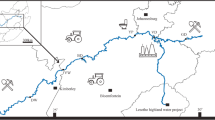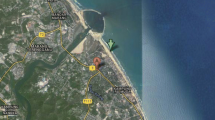Abstract
The unique characteristic of quickly altered but stable response by helminth parasites against metals and elements in a variety of aquatic ecosystems because of pollution conditions merit these as significant markers of fish health as well as of marine and freshwater ecosystems. Biomagnification of toxicants released in aquatic reservoirs by human mediated processes incorporating mining in coastal zones, industrial and agricultural inputs contributed to damaging consequences of human health due particularly to human consumption of edible fish and other biota that are exposed to contaminants in aquatic ecosystems. The metals and elements analysed could be arranged in decreasing order of concentration were found to be, P > Ca > Cd > Mn > Hg > Pb > As > Zn > S > Fe > Al > Cr > Mg > Cl. The association between Echinobothrium deeghai and Rotundocollarette capoori demonstrated surrogate relationship to drain in highly toxic heavy metals like Hg, Cr, As, Cd, from the ambience in the micro-environment of cestodes and nematodes and thus acted as benefactors for the life of the brackish water oceanodromous fish.








Similar content being viewed by others
Abbreviations
- CF:
-
Caudal fin
- DF:
-
Dorsal fin
- G:
-
Gill
- GM1:
-
Gill muscle part 1
- GM2:
-
Gill muscle part 2 (replicate)
- In:
-
Intestine
- L:
-
Liver
- M:
-
Muscle
- PC:
-
Pyloric ceca
- T:
-
Tetraphyllid
- T1:
-
Tetraphyllid part 1
References
Al Naggar Y, Khalil MS, Ghorab MA (2018) Environmental pollution by heavy metals in the aquatic ecosystems of Egypt. Open Acc J Toxicol 3:555603
Bush AO, Fernandez JC, Esch GW, Seed JR (2001) Parasitism: the diversity and ecology of animal parasites. Cambridge University Press, Cambridge, p 346
Don-pedro KN, Oyewo EO, Otitoloju AA (2004) Trend of heavy metal concentration in Lagos Lagoon ecosystem, Nigeria. West Afr J Appl Ecol 5:103–114
Falcao H, Lunet N, Neves E, Iglésias I, Barros H (2008) Anisakis simplex as a risk factor for relapsing acute urticaria: a case-control study. J Epidem Comm Hlth 62:634–637
Hashmi MI, Mustafa S, Tariq SA (2002) Heavy metal concentrations in water and Tiger prawn (Penaeus monodon) from grow-out farma in Sabah. North Bornea Food Chem 79:151–156. https://doi.org/10.1016/50308-8146(02)00123-1
Heckmann RA, Amin OM, Standing MD (2007) Chemical analysis of metals in acanthocephalans 273 using energy dispersive X-Ray analysis (EDXA) in conjunction with a scanning electron microscope 274 (SEM). Comp Parasitol 74(2):388–391
Jaiswal N, Malhotra Sandeep K (2017) Molecular characterization of host-specific raphidascaridoid worms from the gangetic garfish (Teleostomi: Belonidae) in India. Int J Mol Biol 4(6):00158. https://doi.org/10.15406/ijmboa.2017.02.00007
Jaiswal N, Yadav A, Malhotra Sandeep K (2023) Molecular characterization and redescription of alien nematode, Rostellascaris spinicaudatum (Malhotra and Anas, 2001) with revised keys to the subfamilies of family Raphidascarididae and genera of subfamily Raphidascaridinae, Hartwich, 1954. J Parasit Dis (Accepted)
Jezierska B, Witeska M (2001) Metal toxicity to fish. Wydawnictwo Akademii Podlaskiej, Siedlce, p 318
Jhingran VG (1991) Fish and fisheries of india. Hindustan Publishing Corporation, India, p 727
Khaleghzadeh-Ahangar H, Malek MA, McKenzie K (2011) The parasitic nematodes Hysterothylacium sp. type MB larvae as bioindicators of lead and cadmium: a comparative study of parasite and host tissues. Parasitology 138(11):1400–1405. https://doi.org/10.1017/S0031182011000977
Lafferty KD (2008) Ecosystem consequences of fish parasites. J Fish Biol 73:2083–2093
Lafferty KD, Kuris A (2005) Parasitism and environmental disturbances. In: Thomas F, Renaud F, Guegan J-F (eds) Parasitism and ecosystems. Oxford Univeristy Press, Oxford, pp 113–123
Leite LA, Pedro NH, de Azevedo RK, Kinoshita A, Gennari RF, Watanabe S, Abdallah VD (2017) Contracaecum sp. parasitizing Acestrorhynchus lacustris as a bioindicator for metal pollution in the Batalha River, southeast Brazil. Sci Total Environ 575:836–840. https://doi.org/10.1016/j.scitotenv.2016.09.132
Marcogliese DJ, Gendron AD, Plante C, Fournier M, Cyr D (2006) Parasites of spottail shiners (Notropis hudsonius) in the St. Lawrence River: effects of municipal effluents and habitat. Can J Zool 84:1461–1481
Mazhar R, Shazili NA, Harrison FS (2014) Comparative study of the metal accumulation in Hysterothalycium reliquens (nematode) and Paraphilometroides nemipteri (nematode) as compared with their doubly infected host, Nemipterus peronii (Notched threadfin bream). Parasitol Res 113:3737–3743
Mehana EE, Khafaga AF, Elblehi SS, Abd El-Hack ME, Naiel MA, Bin-Jumah M et al (2020) Biomonitoring of heavy metal pollution using acanthocephalans parasite in ecosystem: an updated overview. Animals 10:811. https://doi.org/10.3390/ani10050811
Nachev M, Sures B (2016) Environmental parasitology: Parasites as accumulation bioindicators in the marine environment. J Sea Res 113:45–50. https://doi.org/10.1016/j.seares.2015.06.005
Oyoo-Okoth E, Wim A, Osan O, Kraak MHS, Ngure V, Makwali J et al (2010) Use of the fish endoparasite Ligula intestinalis (L., 1758) in an intermediate cyprinid host (Rastreneobola argentea) for biomonitoring heavy metal contamination in Lake Victoria, Kenya. Lakes Reserv Res Manag 15(1):63–73
Parmar TK, Rawtani D, Agrawal Y (2016) Bioindicators: the natural indicator of environmental pollution. Front Life Sci 9:110–118. https://doi.org/10.1080/21553769.2016.1162753
Reddy KR, Rao PSC, Patrick WH Jr (1980) Factors influencing oxygen consumption rates in flooded solid. Soil Aci Soc Am J 44:741–744
Schludermann C, Konecny R, Laimgruber S, Lewis JW, Schiemer F, Chovanec A et al (2003) Fish macroparasites as indicators of heavy metal pollution in river sites in Austria. Parasitol 126:S61-69
Sures B (2008) Host–parasite interactions in polluted environments. J Fish Biol 73:2133–2142. https://doi.org/10.1111/j.1095-8649.2008.02057.x
Sures B, Nachev M, Selbach C, David J, Marcogliese DJ (2017) Parasite responses to pollution: what we know and where we go in ‘Environmental Parasitology.’ Parasite Vectors 10:65
Vidal-Martínez VM, Wunderlich AC (2017) Parasites as bioindicators of environmental degradation in Latin America: a meta-analysis. J Helminthol 91:165–173. https://doi.org/10.1017/S0022149X16000432
Wong CSC, Li X, Thornton I (2006) Urban environmental geochemistry of trace metals: a review. Environ Poll 142:1–16
Yadav A, Kapoor N, Malhotra SK (2022a) Faunal change over 3 decades to reveal Rotundocollarette capoori n.gen., n.sp., a unique anisakid from Johnius dussumieri from the Central west coast of India at Goa. J Parasit Dis 46:1110–1126. https://doi.org/10.1007/s12639-022-01533-y
Yadav A, Kapoor N, Arif A, Malhotra SK (2022b) Energy dispersive X-ray microanalysis in conjunction with scanning electron micrography to establish nematodes as bioindicators in marine fish environment. J Parasit Dis. https://doi.org/10.1007/s12639-022-01480-8
Acknowledgements
AY is thankful to the Principal and Head of the Department of Zoology, C.M.P.P.G. College for the facilities. Great appreciation is due to Mr. Abul Maaz, Senior Technical Asstt., University Sophisticated Instruments Facility, Aligarh Muslim University, Aligarh, U.P., India for conducting Energy Dispersive X-Ray Microanalysis during investigations.
Funding
No funding or any other financial assistance was received to carry on this investigation.
Author information
Authors and Affiliations
Corresponding author
Ethics declarations
Conflict of interest
We do not have any conflict of interest.
Additional information
Publisher's Note
Springer Nature remains neutral with regard to jurisdictional claims in published maps and institutional affiliations.
Rights and permissions
Springer Nature or its licensor (e.g. a society or other partner) holds exclusive rights to this article under a publishing agreement with the author(s) or other rightsholder(s); author self-archiving of the accepted manuscript version of this article is solely governed by the terms of such publishing agreement and applicable law.
About this article
Cite this article
Yadav, A., Malhotra, S.K. Monitoring of surrogate zoonotic parasites of Anisakidae and Echinobothrium deeghai as bioindicators by application of energy dispersive X-ray microanalysis (EDXMA). J Parasit Dis 47, 793–806 (2023). https://doi.org/10.1007/s12639-023-01625-3
Received:
Accepted:
Published:
Issue Date:
DOI: https://doi.org/10.1007/s12639-023-01625-3




